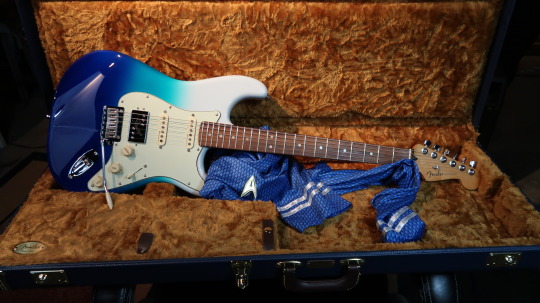#Fender Player Plus Stratocaster
Text
Should I buy a Fender Player Plus Stratocaster?
The Mexican-made Fender Player Plus Stratocaster looks like a LOT of guitar for the money, but is it worth the upgrade, and should you buy one?
First, let’s look at what you get for your money, compared to the basic Fender Player Stratocaster.
Player Plus Noiseless Stratocaster pickups.
Comes fitted stock with Player Plus Noiseless Stratocaster pickups. You’d pay around £200 for a set of USA…

View On WordPress
#Fender#Fender Guitar#Fender Locking Tuners#Fender Player#Fender Player Plus#Fender Player Plus Stratocaster#Fender Stratocaster#Fender Stratocaster Review#Fender Stratocaster Upgrades#Guitar#Noiseless Pickups#Treble Bleed
0 notes
Text

La colección Player Plus, para un nuevo tipo de guitarrista.
1 note
·
View note
Note
I know this is a real basic and vague question but ok computer guitar sounds are amazing to me. Is there a guide for amp settings and specific pedal settings for each player? Something that would be pivotal for each?
We've answered this individually for each player plenty of times, in particular on the artist pages where you can find the gear used for each album and each tour. But to sum up the core of their clean and distorted sounds on that album:
Thom Yorke:
1970s Telecaster Deluxe or 1960s Jazzmaster -> Proco Turbo Rat or Marshall Shredmaster -> ’65 Reissue Twin Reverb
Jonny Greenwood:
1990s Telecaster Plus or 1970s Fender Starcaster
Low gain: Guitar -> Boss SD-1 -> Roland RE-201 -> Vox AC30TBx
High gain: Guitar -> Marshall Shredmaster -> Fender Eighty-Five
Ed O'Brien:
1990s Eric Clapton Signature Stratocaster or Rickenbacker 360 -> Marshall Guvnor or Lovetone Big Cheese -> Mesa Boogie Trem-O-Verb or Vox AC30
Ed and Jonny each used a bunch of other effects for modulation, pitch shifting, delay, etc. If you're curious about that, search their artist pages for specific songs or check the tags for those songs.
In addition, Nigel Godrich added compression, plate reverb, and other effects. However, Nigel stated that the core of their guitar sound on OK Computer was just a band playing in the room, and he used a simple microphone setup:
"I’m not particularly anal about miking up guitars and stuff, as far as I’m concerned you stick an SM-57 in front of the amp and it is what it is. If the sound is good out of the amp then it’ll sound good. And more importantly, you just want to get everything set up so everybody can play!" (The Mix. August 1997).
16 notes
·
View notes
Text
Last week's top 20 videos (2023, week 02)
Top 20 videos last week (January 8-14)
Danny Mattin with Organ Grinder Fish Paper (by Lounsberry)
Strymon El Capistan dTape V2 vs V1 vs Roland RE-201 & Fender Space Delay (by That Pedal Show)
Playing AC/DC with the #BeatBuddy #shorts (by Singular Sound)
#Ibanez DL10 Digital Delay Quick Pedal #Demo #shorts (by mrtolex)
The Smiley is inspired by the first-era, silicon model Arbiter fuzzes. (by JHS Pedals)
JAM pedals | Red Muck (by JAM Pedals)
Jay P testing EvH sound met cool & SuperDrive (by Lex Bos)
?Vol.58??????? Jake Cloudchair??Myriad Fuzz???????? (by The Effector Book)
Vintage 1970 Shin-Ei Uni-Vibe Repair/Restoration Part 4 "How it Should Sound" (by Argenziano Effetti)
Tube booster TubeZoid-B 12AX7 version (by SviSound)
A portable CD player inside a digital delay pedal? (CSIDMAN) (by Anne Sulikowski)
Playing a $5000 Arbiter Fuzz Face & 1963 Stratocaster #shorts (by Pedal Pawn)
Bien plus qu'un compresseur | Origin Effects Cali76 (Stacked Ed.) (by Tone Factory)
Strymon El Capistan V2 ????? ????? (by String6Channel)
Ibanez EM5 Echomachine Teardown! See what's inside! (by Gray Bench Electronics)
Electro-Harmonix Small Stone v Bad Stone: Which is the swirled champion? (by Dickie's 90-Second Pedal Demos)
The Alpha Omega Pi, the Deluxe Big Muff Pi is the most versatile BMP ever! (by Electro-Harmonix)
Sonicake 5th Dimension 11-Mode Digital Modulation Guitar Effects Pedal (by Sonicake)
Conn Multi-Vider Vintage Multi Effects (Octave, Fuzz, Filter) (by Francisco Sanchez de la Vega)
Texas Square face.. Blue. (by Tone Log Vintage Replicas)
Overviews of the previous weeks: https://www.effectsdatabase.com/video/weekly
from Effects Database https://bit.ly/3XndPtS
2 notes
·
View notes
Text
Alyag - Interview & Studio Tour
Studio



Gear List
Line 6 - Helix LT
Universal Audio - Apollo Twin X Quad
MOTU - M4
SPL - 2Control
Genelec - 8040BPM Monitors
Native Instruments - Maschine+
Native Instruments - Kontrol M32
Novation - Launchpad X
SubPac - S2
Guitars (some modded)
Schecter - C-7 Hellraiser
Schecter - SLS Elite E-1
LTD - Alexi Laiho SE-600
Fender - Player Plus Stratocaster
Taylor - American Dream AD17e
Headphones
Slate Audio - VSX
Sennheiser - HD650
Mics
Aston Microphones - Origin
SE Electronics - DynaCaster
Aston Microphones - Starlight
Plugins
UAD, SSL Native, Plugin Alliance plug-ins
Xfer Serum, Synapse Audio Dune 3, Arturia Pigments, Sonic Academy ANA2 soft synths
Native Instruments Komplete 14 Ultimate, and more sample libraries than I care to admit
--
Interview
Who are you and what is your relationship with music?
My name is Alyag, and I'm a lifelong tune-tinkerer, multi-instrumentalist, music producer, and sassball extraordinaire, currently based in Victoria, BC, Canada.
I've been honing the craft of writing, performing, and producing original music since my early teens, and more recently learning how to actually build a business and a career through marketing and monetization.
My main background has always been in rock and melodic metal -- I've played in many a band over the years -- however, more recently I took up the mantle of fusing elements thereof with various genres of electronic dance music. Growing up, I'd always had a tremendous love for both, but the production elements in electronic music (specifically the sound design) had genuinely intimidated me. That is until about a half-dozen years ago when, utterly enchanted by the sights n' sounds of the Shambhala Music Festival here in BC, I'd felt called to take a serious crack at it... and haven't turned back since.
By day, I peddle fine instrumental and professional audio wares at a music store; by night (and every other available waking moment), I'm arranging noise into something that hopefully makes sense, and spreading its gospel across the Interwebz. I've made a humble but steadily increasing income from my creative spewings, via gigs / streaming / sales / sync licensing / etc, and certainly aim to make it a full-time thing at some point in the near-ish future.
I'd go absolutely bonkers were I not doing it, so for me music is literally the thing that gets me out of the otherwise inescapably cozy confines of bed in the morning.
Which piece of equipment in your studio is essential to your production process?
These days I'd say it's the Slate VSX headphones.
Since I'm not currently in a position where I can afford a dedicated studio space, being able to check my mixes in some of the most renowned control rooms on professionally tuned speaker systems, all within my headphones, has been absolutely game-changing, especially in terms of being able to trust that what I'm hearing will ultimately translate in any environment. And being able to do the infamous "car test" without actually having to go to my car is pretty handy.
Also, guitars. Couldn't do without at least one (or several) of those.
What is the most budget-friendly piece of studio gear that gave you the most results?
If we're talking bang-for-buck ratio here, I'd still say the Slate VSX. They aren't cheap headphones by any means, but when I think of the amount of money I've sunk into my monitoring environment over the years -- between speakers, room treatment, calibration software, a fancy speaker switcher/controller with built-in cross-talk emulation for headphone mixing, the headphones themselves, a Sub Pac, you name it -- the value I've gotten out of these particular headphones over the past year and a bit I've owned them has far surpassed anything I'd used previously, at a fraction of the cost.
Beyond that, I'm a big fan of less expensive gear that "punches up", if you will; stuff that is oft pitted against much more expensive brand products. For example, my favorite mic for anything acoustic or clean vocal is the Aston Origin -- relatively cheap when compared to the Neumanns and the AKGs of the world, but it's the one I always go for whenever I record any of that sort of material, just because I've always loved the unique character it would impart on the recording, and how little processing it would need after the fact to sit great in the mix. It's also quite forgiving on ambient noise, which helps when you're a bedroom producer with a less-than-perfect space.
I've also found that certain cheap, almost "throwaway" instruments for some reason can record inexplicably well compared to (or at times even better than!) their higher-end equivalents. And taking it further than that, the beauty of the amount of processing anyone with a DAW has at their disposal these days, is that you can take any recorded signal and transform it into something so much more than it once was in endlessly creative ways... so it really isn't necessary to have all of the best stuff to make great tunes. I'm a firm believer in the concept of, "good enough", rather than ceaselessly chasing better and more expensive gear.
Walk us through your process for creating and producing music.
Every tune is different, and while I do try to mix things up every once in a while (starting with drums or a bassline instead of a melody, for example), I'm always open to where a new idea might spark.
Sometimes it could be as simple as flipping through presets in a new plug-in when something clicks; sometimes it could be a cool arpeggio stumbled across by happenstance by fretting the guitar in some unusual way; other times a random melody will pop into my head, and I'll try to map it out either on the guitar, or directly via MIDI in Ableton, and build on it from there.
A lot of my catchier tunes will typically start in the latter way, with a couple having even come to me in a dream... which is always a rare and precious moment followed immediately by my frazzled half-awake self scrambling out of bed and toward the computer to try to somehow capture the damn thing before it completely dissolves into the ether.
What is a production technique that you always come back to?
I don't know if I'd necessarily call it a technique so much as a preferred method, but I've never gotten out of the habit of programming all my drums entirely by hand via clicky-mouse -- as in, I literally write in every single note and adjust its velocity with the pointer.
Sure, I have drum pad controllers I could use to actually play in the percussive parts, but I've done it this way for so many years that it's just faster and somehow more efficient for me. It doesn't matter if I'm making melodic death metal or electronic dance music; the method is exactly the same, just the samples are different.
How would you explain your style?
Historically I've referred to my tunes as an eclectic amalgamation of Electro-Psy-Funk-DnB-nuDisco-Trance-Metal, which is a bit of a mouthful, hah. Thus far it's the best way I've come up with to describe my noise making antics, as they very much are as cohesive a blend of all of those conventionally-rarely-seen-dancing-together elements as I can possibly muster. Being a tremendous fan of a plethora of highly varied genres and styles, I've never been keen on pigeon holing myself into any particular one, rather opting to fuse together as many of my favorites as possible.
That being said, I'd say a fairly accurate (as I imagine it) explanation for my music would be the soundtrack to a high-stakes hover car race in a dystopian future cityscape whilst in the midst of a legendary boss battle.
What’s your biggest struggle?
Ironically, being the jack of all yet master of none in terms of niche genres makes it very difficult to appeal to curators or even labels that specialize in specific styles of music.
Often times if I try to pitch my stuff for promotion, I'll get feedback citing that it's too much of one thing and not enough of another (namely the one that they specialize in), and thus it doesn't quite fit their mold... which is precisely why I've remained 100% independent with all of my releases to date (with the exception of a couple of collaborations with other artists on their labels).
The benefit thereof, however, is that I retain all the rights to and creative control over my work, so I don't have to cater to anyone or anything other than my zany imagination.
Has building a hardware setup changed your perspective on music or life in general?
I actually do most things "in the box", and own very little hardware, as I'm pressed both for budget and space.
If anything, I've been trying to simplify my setup more and more over the years, downsizing quite a bit from what I'd used to have. For example, instead of a hefty studio rack, I now do everything on the Apollo Twin; in place of a gargantuan tube guitar amp, all my tone comes from the Helix floorboard; and instead of a band, I have my laptop, hah.
So I suppose that if I've drawn any life lesson parallels here, is that the simpler the better (at least for my own peace of mind), and the less I have to cart around to gigs and such.
One tip on how to spark creativity?
I think creativity is akin to a muscle -- exercised regularly, it grows stronger and more efficient; left to stagnate, it atrophies. So based on that analogy I'd say the most important way to maintain it is to keep doing creative things, even if only a little bit each day. Taking that same analogy a tad further, there have been studies in physical fitness that show that one receives the same amount of health benefits from light daily exercise as they do from a couple of heavy work-outs with longer periods of recovery in-between. Which is to say that, even shorter bouts of creative output multiple times a week will likely yield similar amounts of progress as one solid day of continuous flow.
And here's the thing: in the context of, say, an independent music producer who already wears many hats in the writing/engineering/producing/releasing/marketing process, creativity doesn't just mean making music. It could pertain to making a social media post; writing an email to your mailing list; updating the bio on your website; designing new merch; creating ancillary video content that delves into the production story of your new release; answering questions in an in-depth interview (ahem) -- you name it -- it's all a form of creativity... and at the end of the day, as a creative person, all of those many ways amount to flexing that muscle.
The goal is merely to keep doing the things.
A book, movie, article, or album that has inspired you?
"The War of Art", along its follow-up, "Turning Pro" by Steven Pressfield are a absolute must-reads for any creative.
Relatively quick reads, but the sense of creative empowerment and drive they instill in you cannot be understated.
Where can people find more of your music and connect with you online?
Official Website
Bandcamp
Spotify
SoundCloud
Facebook
Instagram
--
In Case You Missed It
47 - Generative Ambient
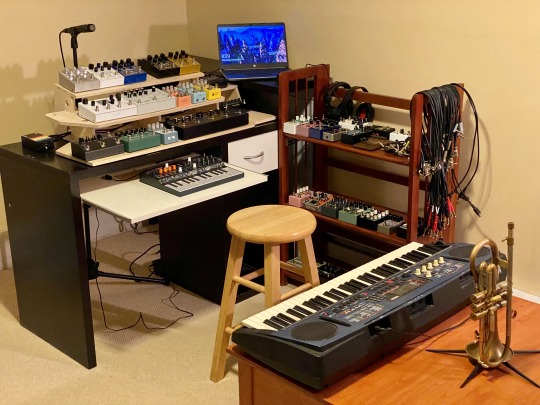
--
Friends, this is a past issue from the G.A.S. Newsletter. Every Tuesday and Friday a new artist is featured.
#studiotour#producerlife#musicstudio#homestudio#mystudio#producer#musicproducer#synthesizer#soundengineer#sounddesigner#beatmaker#musician#eurorackmodularsynth#eurorack#electronicmusic#gasnewsletter
0 notes
Video
youtube
This Is '22 - If you can’t get enough of that glam-rock muted guitar sound, like myself, then you should check this out. Straight ahead rock with a deep pocket and the sound of my Fender ‘Player’ Stratocaster, Tobacco Sunburst with maple fretboard. Plus Native Instruments Guitar Rig 6 for all the effects.
0 notes
Photo

Say hello to my PRETTY NEW FRIEND!! 😍😍😍😍 I’m in an absolute state of shock. STILL. Have you ever been in a guitar store and wished you could just take the guitar you want home? Without the big ol’ price tag? Well that dream just came true for me. Carlos, the UNBELIEVABLY SWEET AND KIND owner of the music shop I go to, the only one I go to! Because small business!! Guitar Center doesn’t need more business!! Anyway, the owner of Guitar Wars.. GAVE me this beauty as a Christmas present. Bruh. WHAT?! I went down there to buy this Telecaster cuz I fell in love with it last night, couldn’t put it down and didn’t want to leave it at the shop lol wanted to take it hoooome... and he knew that haha. He let me gather up the guitar and a gig bag and even a STRAP... in addition to a brand new amp to replace the used one I’d brought in for him to fix... and then he went “Merry Christmas!” Waved me off when I tried to pay....... 😱🤯 I tried to tell him no!! but he was really excited and happy to do it so what can I say??? I gave him a hug. I can’t even imagine a cooler, more amazingly badass present. Just wow. Anyway, please say hello to Mikhailo.. aka Mickey. 😅 I mean why not name it after who I love most?? 🥰 Specs! It’s a Fender Modern Player Telecaster Plus, meaning it has an extra pickup and a hum-bucker, so it can create a lot more sound varieties than a normal Tele. The body is made of pine with Honey Burst coloring and the neck is maple. Two extra stops on the pickup selector/lever AND a coil-split switch for the bridge hum-bucker to... do more things that change the sound 😂 I don’t understand any of the technical aspects hahaha it sounds neat though!! Gosh she is beautiful. Just like Mickey Milkovich/Gallagher... amiright? 😏 #fender #fenderguitars #fendertelecaster #telecaster #electricguitar #musicalinstruments #rocknROLL #featuringmy #stratocaster #fenderstratocaster https://www.instagram.com/p/CI2WMvsBN0XezAK86tz9td2jhuo7SzMG_-K3PU0/?igshid=4orgxnln5p1i
#fender#fenderguitars#fendertelecaster#telecaster#electricguitar#musicalinstruments#rocknroll#featuringmy#stratocaster#fenderstratocaster
1 note
·
View note
Text

Fender Player Stratocaster Plus Top Maple Fingerboard Aged Cherry Burst
4 notes
·
View notes
Text
Is it worth modifying a Standard Telecaster to fit humbuckers?
Note: we don't do affiliate marketing or sponsorships, so we don’t get any money if you buy any of the gear mentioned in this article. If you do buy something because of us, we don’t ask that you donate to us, but why not donate to a good cause? If you can afford another pedal, you can afford to do that.
Recently we’ve gotten various Jonny-related questions about Telecaster pickups configurations and about converting a Telecaster Standard into a Telecaster Plus using the Lace loaded pickguard. Before giving advice on how to modify a Tele, it seems worth asking whether it’s worth it. The first consideration is that both pickups of the Telecaster Plus V1, Jonny’s main guitar with Radiohead, are voiced as humbuckers, while both pickups on a standard Telecaster are true single coils. Despite its shape, Lace claims that the Blue pickup (found in the neck of a Tele Plus V1) has a “warmer 50's humbucking sound in a single coil configuration” (Lace). Additionally, in recent years Jonny has used a range of guitars, from his stolen-and-reacquired 90s Tele Plus to Thom’s old Tele with a Gibson PAF, from his 70s Starcaster to a 2014 Modern Player Starcaster reissue, from his 70s Les Paul Standard to various Les Pauls rented on tour in support of Junun. These guitars use a wide range of pickups (including CuNiFe Wide Range pickups in the case of the 1970s Starcaster), but they all use humbuckers. So you should really ask whether it makes sense to buy a single coil guitar for it’s look/shape and then modify it, when Jonny seems happy with the sound of any humbuckered Fender.

A photo of Jonny playing Thom’s “Tele3″ at a performance with the London Contemporary Orchestra in Budapest on October 17, 2015. The guitar is a heavily-modified 70s Telecaster Standard featuring a ‘57 Gibson PAF in the bridge, an unknown humbucker in the neck, and artwork by Thom.
Humbuckers, including the pickups in the Lace Tele Plus JG loaded pickguard, will not fit on a standard Telecaster guitar, which is routed (i.e. has space in the wood of the body cut out) for single coil pickups. And even standard (Stratocaster-sized) single coils won’t fit in the neck position of a Standard Tele, since it only has space for the smaller chrome Tele neck pickup. The loaded pickugard will only work with certain (not all) Telecasters which already have humbuckers. Examples of Teles which would fit the loaded pickguard include the Fender Player Telecaster HH and the now discontinued Fender Modern Player Telecaster Plus. Both have 22 frets, like the original Tele Plus and unlike most standard Teles. Ironically, the stock pickups of the Player Tele HH will be closer to the sounds Jonny likes than the stock pickups the Modern Player Plus, despite the name. The single coil neck pickup of the Modern Player Plus will sound like a standard Telecaster, unlike the Lace Sensor Blue neck pickup of the original Tele Plus V1 which is voiced like a humbucker. The Player Tele HH is also relatively inexpensive and comes in sunburst finish, so in general it seems like the best option if you really want the traditional Telecaster look/shape but with humbucker pickups. You may decide you don’t even need to swap out the pickups at all.
If you care less about the appearance, there many versions of the Telecaster Deluxe (favored by Thom in the 90s) and the Telecaster Thinline (‘72 version), all of which are fitted with humbuckers. You won’t be able to use the pickguard from the Lace loaded set, but you’re probably better off buying the pickups individually anyway (compared to buying the pickups individually, you’re essentially spending $30 USD on a black piece of plastic). Although in construction the “Wide Range” humbuckers in Fender reissues like the Deluxe Tele are closer to Gibson PAF pickups than to the original pickups they claim to replicate (they use bar magnets instead of CuNiFe pole piece magnets), they clearly sound good enough to Jonny since he used a 2014 reissue Starcaster for performances in Budapest and Italy.
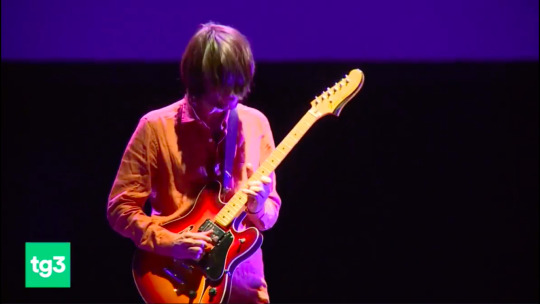
Jonny playing a 2014 Fender Modern Player Starcaster reissue in Fermo, Italy in October, 2019. Screenshot from his interview with Tutta un'Altra Musica.
To use the Lace Tele Plus loaded pickguard with a standard Telecaster, you’ll need to route the body to fit a humbucker. You’ll also need a new Hardtail-style bridge, and there will be a visible hole in the body between the humbucker and the bridge. A better option is to purchase the pickups individually, and to purchase a Telecaster-style bridge plate designed to fit a humbucker. That’s exactly what Plank (the band’s guitar tech) did in the 90s when he converted an American Standard Telecaster into a Telecaster Plus V1 to use as Jonny’s backup (see “Tele2” on Jonny’s page). That sort of bridge plate is also what Plank used when he added a bridge humbucker to Thom’s Tele3. But even if you do get that bridge plate, you’ll still need to route the guitar to fit the humbucker – the larger bridge just covers the hole. Unless you already own routing equipment, or you want to start modifying guitars more heavily in the future, the combined cost of the new bridge plate and tools (or paying a tech, often just as expensive) mean that it doesn’t make much sense to do this compared to buying a guitar that’s pre-routed for humbuckers.

One can see the Telecaster-style humbucker bridge plate on Jonny’s 90s American Standard Telecaster in this screenshot from Radiohead’s performance of Exit Music at the Eurockéennes de Belfort festival on July 4, 1997.
10 notes
·
View notes
Photo
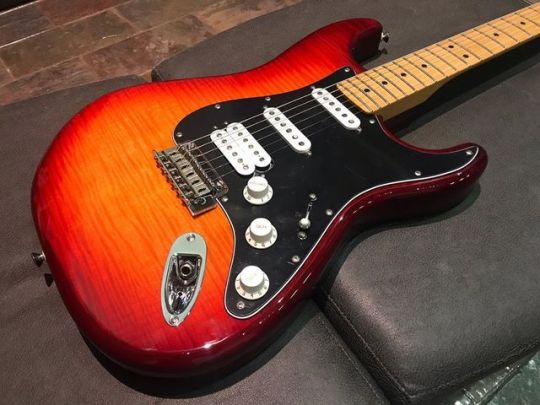
Spotted in the lobby: Player Series HSS Plus Top. I have documented this finding for your Friday enjoyment. 📸 #fender #fenderguitars #strat #stratocaster #hss #strathss #playerseries #fenderplayerseries #plustop #happyfriday (at Fender) https://www.instagram.com/p/B3xXaiHB0qj/?igshid=1pcbvqbjt75p7
#fender#fenderguitars#strat#stratocaster#hss#strathss#playerseries#fenderplayerseries#plustop#happyfriday
2 notes
·
View notes
Text
Choosing the Best Electric Guitar For You

When it concerns selecting the very best electric guitar, numerous considerations enter into play. The very best guitar for me might, for a range of purposes, stop being perfect guitar for you personally. Exactly why is that? For the basic reason that we're not all developed the exact same fashion and neither are guitars.
When evaluating guitars, cost is generally a key concern. The majority of us are running within a budget along with a Gibson Les Paul Custom, really a second hand one on eBay, is gon na set you back a great $3700. You are able to really find excellent guitars available for under $400, and so do not assume much because a guitar is costly that it is gon na be best for you. My tip is finding the ideal Instrument for yourself and then save up the money of yours if necessary.
Most likely the most important options that come with a guitar are playability and tone. These 2 variables differ widely from instrument to instrument. A single coil Fender Stratocaster made out of alder will seem different from a mahogany bodied Gibson Les Paul built with humbucking pickups. The single coil pickups are going to give it a sweet, clean, rich tone. Good for actively playing the blues. The humbuckers are going to be much more appropriate for any rock or maybe metal music genres (although 1 can certainly play blues with them as well).
Alder wood gives a better tone than mahogany that's rich and deep. Guitars made out of basswood are a little less heavy sounding than alder, less than as strong sounding. This's extremely subjective of course. Many great guitarists as Joe Satriani have preferred basswood guitars for a long time. Basswood is lighter compared to alder which is significantly lighter than mahogany. Pete Townshend gave up actively playing the Gibson Les Paul of his on stage for two hours every evening because the point was very heavy (typically aproximatelly eleven pounds). He switched to some Gibson SG that's much more comfortable to play although it's a unique tone because of its smaller mahogany body.
Playability describes the way your fingers fit around the neck, the smoothness of the neck, its radius and width. Some guitars fit the hand of yours such as a glove and some make playing them a task. Everybody's hands will vary, some with longer toes or maybe smaller hands, therefore playability is a lot a private point. Though it's a very important thing since you'll be playing that guitar a LOT in case you're at all serious. The most effective necks I've previously played had been on an Ernie Ball JP6 and a Charvel So Cal. The most terrible was on a Gibson Les Paul Custom which has a painted neck plus was tacky (sticky) whenever your fingers perspired actually a bit of bit).
So for these reasons it's advisable to never ever purchase an electric guitar online only since it looks cool or since the preferred guitarist of yours plays it. It is okay to shop online and choose a couple of versions that you love, but always attend a local music shop and actually enjoy them before you purchase. Hear the variations in tone. Notice just how the neck feels in the hand of yours. It does not matter whether you cannot play yet. Try letting the product sales clerk plug you into an amp plus merely strum several simple chords. Notice just how broad is the neck? Exactly how heavy is the neck? Others are as a baseball bat and some are level and created for shredding.
Allow me to share several of my favorites:
For a guitar under $400 you are able to get an excellent used Mexican Strat off eBay. These guitars are made very almost and the American Strats except they're made particularly across the border in Mexico. Great value for money and an excellent guitar which almost anyone will love. However, usually play one first and also ensure it feels great to you. Then shop for a cost.
For the blues you cannot match an American Fender Stratocaster. These run aproximatelly $1200 brand new though you are able to always get a more affordable used 1 on eBay. They come with an assortment of pickup configurations so that you are able to buy a humbucker if you need one to play somewhat more raunchy numbers. Though the coils sound very fresh and heavenly (especially the 1969 reissue pickups) they are ideal for the blues.
I've constantly been partial to Gibsons, both Les Paul and also the SG models. Great for blues too but also great for rock, particularly the SG. These guitars are generally played with a bit of amount of distortion, so in case you are into metal or rock then these're generally a sensible choice. I do not just like the painted necks however because of the reason mentioned above.
Ibanez creates a big line of guitars covering nearly every style of playing. They're recognized to be well made and affordable when compared with Gibson or Fender. They focus on shredders and metal players a lot of the necks of theirs is flatter and thinner as in contrast to some other makes. Due to their affordable they make excellent very first guitar choices. However, constantly try before you purchase.
Find More Information: Guitarscamp
youtube
1 note
·
View note
Text
Buzzsaw on Quaaludes: Killing Joke and the Guitar Stylings of Geordie Walker
Killing Joke has had a sole guitarist since its formation in 1979; a man who never receives the credit he deserves, save from the countless musicians he has inspired and his fans. He is a guitarist's guitarist – a player whose genius you cannot fully appreciate, unless you yourself share his craft. His name is Kevin Walker; but is known to most as ‘Geordie’.

Geordie Walker performing in Finland, 2009. (Photo by Thomas Vitikainen)
There aren't very many guitarists, whom you can recognize on a track solely based on style of play. Geordie Walker is certainly one of them.
Wikipedia describes his "unorthodox style of play" as "Byrds-like chiming arpeggios of repetitive and somewhat somber melodies with a hypnotic long-sustain tone". It is one reason why his play is so instantly recognizable and fascinating, but it is not the whole story.
While experimental in his ethos – and possessing a first wave post-punk background similar to Daniel Ash, Bernard Sumner, or Billy Duffy – Geordie Walker is a different species from these three. He bookends the fiddly, reverberating, scratchy, ingenuity of post-punk instrumentation, with some of the most inventive and memorable heavy riffage in rock history.
This is something which the mainstream has completely failed to bestow due credit for, in spite of concurrently acknowledging his "influence" the scant few times it has deemed him worthy of mention. This is an injustice which Killing Joke as a collective musical unit has long struggled with – the namedropping of stars who have owned their records, taking precedence over their actual music.
Early Output
London-based Killing Joke started out as a wonky dub outfit, releasing their first EP, Turn to Red, in 1979.
While perfectly adequate, within the narrow confines of the style of music his band was then playing; Walker's work on this release was not overly remarkable. It was within the following year, as the band began to take a more aggressive sonic approach – in response to the energetic environment of live shows – that he began to break the mould.
The 1980 single ‘Wardance’; accompanied by the equally famous b-side Pssyche; is a deliciously primitive release. ‘Wardance’ is what would happen if a Neu! cover band, or some other krautrock outfit, performed in "The Upside Down" from Stranger Things. A savage caveman beat by drummer Paul Ferguson introduces a fuzz-laden funk bassline. Then, Geordie does something quite interesting:
His riff on this song is one chord; played with the "scat" rhythm which has long been an aural trademark of reggae, dub, and ska. There was nothing remarkable about this in 1980 – The Clash, as well as other British punk and post-punk acts had been there, and done that. But this particular instance of it, was played with heavy distortion on the open E string – the lowest possible chord in E standard tuning. In other words, this was less of a "scat" and more of a "thwomp".
This minor change to a rather stale trope, was simply a stroke of genius. Killing Joke has downtuned their instruments since the early 80s; and as this video of them performing the song here in the teens shows, it has made the song even more utterly monstrous as it has aged.
On these earlier releases, Geordie Walker had not yet built up his distinctive style to its classic form. The Turn to Red EP, ‘Wardance’ single, self-titled Killing Joke debut album of 1980; and follow-up, what's THIS for...! (1981); were all recorded in E standard tuning, rather than the lower D standard tuning, which has now been used by Killing Joke for about thirty-five years.
More importantly, on all of those releases; plus 1982's Revelations; Geordie is without his most recognizable trademark: his yellow-gold, hollow-bodied Gibson ES-295 guitar. He had not purchased it yet at this time, and instead used a Gibson SG.
[Edit: I've also seen a video of a television performance from this period where he has a Fender Stratocaster, but the band is miming along to a studio recording, and I see no evidence that he ever used it in the studio or during any real live performances.]
Walker's nascent sound on these first four releases was thin and wiry; it is high-pitched, sharp, and has very clear definition, in contrast to his later multilayered textures, blanketing eerie harmonics. But it still has its charm, and the work he does with it is still very recognizably Geordie. But this was Geordie Walker 1.0: a sound that he would leave in the early 80s, and never again return to.
Recently, Jaz Coleman joined the Foo Fighters onstage in Prague to perform ‘Requiem’ off of Killing Joke’s first album. Although the performance is dreadful aside from Jaz Coleman's vocals, I noticed two things: first, three guitarists combined, sounding far less impressive than Walker does on his own; but also, that this may have been the first time that Requiem had been performed in its original tuning by a member of Killing Joke since 1982.
Killing Joke (1980) was the band's debut album, featuring many songs which would later become staples in Killing Joke's live setlist. It begins with the aforementioned track Requiem; a slow, thumping, buzzing, clockwork eulogy for humanity after an apocalypse.
When performed live, to lessen the monotony of repeating the riff throughout the whole song, Geordie will often do some improvisation following the first chorus; slide up from the second fret to the fourteenth to play it during the second and third choruses; or switch from the neck pickup to the bridge pickup during the second and third verses, to back up Jaz Coleman's vocals with a more muddy, chiming tone. All of these live quirks can be seen exhibited during this performance of the song.
Also of interest on the debut album, are ‘The Wait’, a white-hot early industrial metal masterpiece, which contains what may be the grandest riff of Geordie Walker's career. S.O.36 is a rarely-performed, extremely underrated cut, for which he provides dissonant, ghostly arpeggios. I also find the riff of Primitive fascinating; because, (to me, at least) it bears some resemblance to Ron Asheton's riff on The Stooges' ‘T.V. Eye’. Walker is such an underivative guitarist, that it's intriguing when he actually gives glimpses of who his influences may be.
Walker's sound began to evolve on 1982's Revelations. I personally consider it to be a quite mediocre album, but Geordie has his moments on it. The guitar on tracks such as ‘The Hum’, and ‘The Pandys are Coming’ is bone-chilling. This album was supposedly the first on which Killing Joke downtuned their instruments – but only a half step down, instead of the full step D standard tuning which would first appear on 1983's ‘Fire Dances’.
Geordie's tone on the album is far different from the two that preceded it. The distorted, wiry, scratchy, sound of those early releases, was replaced with an airy, clean chime, with a boost to the mid-range frequencies. The result is guitar parts which have a clattering, messy smack to them – instead of a razor edged high-end hiss.
Fire Dances
The sound Walker introduced on Revelations was taken to a logical conclusion the following year, on Fire Dances (1983). The most significant development of his guitar work on this album, was the debut of his signature hollow-bodied 1952 Gibson ES-295. It was a milestone, as swapping out a solid body for a hollow one gave his sound far more resonance and presence.
"I kind of noticed that if you're using a really distorted sound, if you play complex chords, because of the harmonics in the distortion the chord will fucking disappear. I thought... if I got a semi-acoustic I could put like, a contact pickup in it and mix the acoustic sound with electric sound... and I got an old Gibson fucking catalog and I spotted it."
-- Geordie Walker in 2011 (source)
Originally released for use in big band jazz; and other forms of pre-rock 'n' roll music; in 1952, it gained notoriety as Scotty Moore's instrument of choice on Elvis's early singles. Its gold paint-job was considered outrageous at its time of release.
"To me, a hollowbody is the sound of wood making music. A solidbody is the sound of an amp."
-- Scotty Moore, 2015
Of course, in the world of distorted hard rock, and heavy metal, seeing such guitars onstage is rather a rare occurrence. It wasn't at all unheard of in the post-punk and new wave scenes (Billy Duffy comes to mind), but those players don't implement the heavy chugging, nor display other such metal influences, like Geordie does.
The first time I ever saw a video of Killing Joke performing live, I was a bit amused seeing what appeared to be an old fuddy-duddy rockabilly guitar, being used to play songs like ‘Asteroid’ or ‘Total Invasion’. I believed that the man laying down these tracks must have been a long-maned, bearded, metalhead in a t-shirt; and that the robust sound I was hearing must have been an illusion created by studio multi-tracking. I doubt that when anybody hears post-nineties Killing Joke for the first time they imagine an aloof, well-dressed gentleman nonchalantly strumming away at an Elvis guitar whilst puffing on a cigarette.
Fire Dances is Killing Joke gone psychedelic, featuring upbeat songs with vocals that alternate between childishly whimsical, and completely frantic. Geordie contributes off-kilter, dizzying melodies with a playful mood to them.
It sounds as though his bridge pickup began to see frequent use on this release, a development that would greatly expand his versatility both in-studio and onstage later in his career. A switch of pickups can be detected by the replacement of his high-end chainsaw neck pickup tone with a wet, bell-like chime. Nowadays, on many songs he will switch to his bridge pickup during verses (see: ‘Requiem’, ‘S.O.36′, ‘Primitive’, ‘Pandemonium’, ‘The Great Cull’); and on some songs he will do the opposite (see: ‘Love Like Blood’, ‘Autonomous Zone’, ‘Majestic’, ‘Hosannas’, ‘This Tribal Antidote’).
The New Wave Years
Geordie Walker's liberal usage of delay effects on Fire Dances became a staple of his sound in the commercially successful years which followed.
On 1984's Night Time, it can be argued that his sound finally progressed to vaguely what we hear today. Palm-muting and distortion made their return to his repertoire; however, instead of the icy “Geordie Walker 1.0″ sound of the first two albums, his tone maintained a resonance, density, and an imperial dignity of sorts, from Revelations and Fire Dances.
The exact combination of effects used by Walker from Night Time onward are oft-mistaken by those trying to imitate his sound. Chief among these misconceptions is that he uses a chorus pedal.
I have seen many people ask how to get their setup to sound reminiscent of Geordie Walker's on forums, and the other users will more often than not recommend chorus or stereo chorus effects. After spending countless hours fiddling around with my own guitar setup; and watching videos of Killing Joke performances, and interviews with Geordie (a very rare thing to come across); I strongly believe that he does not use – and probably hasn't ever used – chorus effects.
Delay Pedals
Instead, the resonance of his sound comes from (aside from his hollowbody guitar) clever usage of delay pedals. The users of EquipBoard, have compiled a list of some models he is seen using in various videos and photographs. They include:
The Line 6 DL4 Stompbox Delay Modeler. Spotted in a video from 2006 during the “Hosannas from the Basements of Hell” sessions.
The Electro-Harmonix Deluxe Memory Man (era not known).
The delay pedals are set up in a way which mimics chorus, but excludes some of the more "wet" elements of it. To hear the difference, listen to Killing Joke’s ‘Eighties’, followed by Nirvana's cheeky recycling of its riff in ‘Come As You Are’. On the latter, Kurt Cobain is using chorus, and the difference is quite apparent.
I also suspect that he uses a tiny amount of a phaser effect, to give his sound more ‘shimmer’; but I have no evidence to support this as of yet.
Automatic Double Trackers
Geordie also uses automatic double trackers (ADTs) to replicate the layered guitar sound on records – usually only attainable in the studio. He claims to use two at once, which is undoubtedly a paramount component in the constitution of his gargantuan sound.
The ADTs he uses are "Parmee Acoustics and Collins Electromagnetics (PA:CE) Automatic Double Trackers".
Unfortunately, it appears that the company which manufactured these is long-defunct, and as such this unit is no longer in production (as of December 2018, Ebay appears to not have a single one listed). It is described by Fletcher Stewart at Tone Report to be "perhaps one of the most elusive effect units ever made". Stewart, who was able to cop one of the devices off of the internet somehow, described its key features as "the thickest liquid stereo chorus imaginable, chewy true pitch vibrato, sine wave flanging, detuned slap back and more".
The settings on the PA:CE ADT unit Geordie makes use of, are the slapback and detuning features; which are applied sparingly.
While this specific unit may be nearly impossible to locate nowadays, an automatic double tracking effect can be created by nearly any modern delay pedal which boasts multiple outputs and a modulation feature. Modern ADT units are also available for purchase, but I cannot vouch for their aural similarity to Walker's.
Amplifiers and Heads
In the eighties, Geordie used Burman cabinets. Burman is a defunct brand, and I can find no record of it existing after that decade. As such, they may also be difficult to get your hands on.
At some point following that decade, Walker switched to a Marshall EL34 100/100 Power Amp, used with a Marshall JMP-1 Tube MIDI Preamp. Since then, he has alternated between various Marshall heads, and Framus Dragon Heads. Similarly, he has also used both Marshall and Framus speakers in conjunction with different combinations of those heads. During the Killing Joke 40th anniversary tour of 2018, he can also be seen using speakers made by Blackstar; a UK-based manufacturer founded in 2004.
The Nineties
Walker's guitar work appeared on four albums in the nineties: Killing Joke's ‘Extremities, Dirt, and Various Repressed Emotions’ (1990), ‘Pandemonium’ (1994), and ‘Democracy’ (1996); and industrial super-group Murder, Inc.'s eponymous 1992 album.
Geordie became conspicuously more influenced by hard rock and heavy metal during this period, readopting a heavily overdriven sound for the first time since 1981 for the proto-grunge Extremities, as well as Murder, Inc.; and later introducing Ministry-esque crunchy, repetitive palm-muted power chord riffs on Pandemonium. This was a turning point, as the remnants of Geordie’s new wave past were nearly completely cast into the rear-view mirror.
The musical climate of the late eighties and early nineties essentially saw the end of new wave and synthpop, as bands for whom Killing Joke's early output had been a key influence began to break into the mainstream. This, combined with the abysmal reception to Outside the Gate – an oft-forgotten and widely-panned 1988 album which Geordie’s guitar is barely even audible on – spurred the band to go loud again.
Walker experimented a lot during this period, pulling many new tricks out of his bag which would not, ultimately, carry on into the next decade and beyond. The song ‘Whiteout’ off of Pandemonium is the only Killing Joke song to feature liberal use of a wah pedal. Live performances of ‘Exorcism’, ‘Millennium’, and on occasion, ‘Whiteout’, would see Walker briefly swap his beloved ES-295 for a sunburst Gibson Les Paul Standard outfitted with white single coil pickups. This guitar was only used for these specific songs during tours in 1994 to 1996, and has not been used onstage by Geordie since.
The reason why Geordie Walker decided to bring a guitar which wasn't an ES-295 on tour with him for the first time since the early eighties is not known to me. Occam's Razor suggests he thought that the fat palm-muted tone (on the studio versions of the aforementioned tracks) would be best suited by a solid body guitar; rather than the more airy and resonant hollow body. I've never seen it discussed in any interview of his, nor did the Les Paul ever return when those songs were played on later tours. Regardless, for a brief period, it seemed Geordie didn't believe his ES-295 to be capable of providing the sound necessary for the band's heavier cuts.
It should also be noted that 1996's Democracy featured acoustic guitar overdubs on many of its tracks. Outside the Gate had also seen some sparse usage of an acoustic; but on Democracy, it is often front-and-center, especially on the title track. This was to be the last time acoustic guitar would appear on a Killing Joke album, but in a 2011 interview Walker didn't rule out the possibility of it returning for a future release.
2003 and Beyond
Killing Joke's heaviest album to date, I believe, was their 2003 self-titled release; produced by Gang of Four's Andy Gill, and featuring Dave Grohl as a guest musician on drums. Interestingly, Geordie was reportedly unhappy with how this album was mixed; which is understandable, considering the heavily-compressed loudness war production on the album, which was common in the early naughts.
His sound on the album is a beefed-up update to that which was used on the band's first self-titled album in 1980. It is ferocious, bordering on inhuman. It dominates the album, rendering the bass almost inaudible on most tracks.
‘The Death and Resurrection Show’'s palm-muted two-note riff is primitive and utterly brutal. ‘Asteroid’ sees Walker adopt drop C tuning for the first time, and the song has become Killing Joke's signature thrasher – a setlist staple which has appeared in almost every tour since 2003. Another notable Geordie moment, is ‘Blood On Your Hands’, which has an unusual, dissonant riff that sounds like a groove one would hear on an electronic track.
The 2003 release served as a template for successive new entries in the band's discography. Geordie’s style was perfected at the beginning of the new millennium, and has not seen much change since.
On 2006's Hosannas from the Basements of Hell (my personal favourite Killing Joke album), his sound is heard at its rawest. The high end on the guitar, on this album, could peel paint off walls. Listening to it makes me feel like I'm being devoured by a great machine, or being dragged on scorching hot asphalt. I've seen mutterings on the internet, that the guitar on the album's closer, ‘Gratitude’, is Geordie using a violin bow on his ES-295; but besides his expressed admiration for 60's mod rock outfit The Creation's use of the trick, I can't substantiate this.
While Geordie Walker has shown less interest in evolving his sound since 2003 than he did beforehand; the quality of his playing has been very consistent. Killing Joke's post-reunion renaissance has yielded some of their greatest songs, and Walker's outstanding riffs have been absolutely crucial to their success.
Now entering his sixties, it's a great disservice to music that he is never given his due. But most seem content with dusty old blues rockers, "iconic" hard rock axemen who are frozen in the year 1989, and the same ProTools-molded landfill bilge regurgitated ad nauseum. Geordie Walker, despite his middle age, continues to breathe life into what has become a monotonous contemporary rock & roll listening soundscape; and I hope to god that there will one day be far more unorthodox sounds out there, such as the one he has spent decades meticulously crafting.
Videos
2009 Instrumental Demos
Documentary Excerpt featuring Geordie Walker and the ES-295
Interview with Geordie Walker (2011)
Playlist of Ten Geordie Walker Instrumental Demos (2007)
#Geordie Walker#Killing Joke#Guitarists#Murder Inc.#Gibson ES-295#Gibson#Post-Punk#Burman#Framus#ES-295
4 notes
·
View notes
Text
We could become slaves to our equipment...volume 2
WARNING: GUITAR GEEK LANGUAGE FOLLOWS
David Lindenbaum is the second half of the Pigs on the Wing guitar team and an accomplished solo artist in his own right ( check out his solo album Ether Day if you have done so yet). While Dave is an old hand at performing Pink Floyd’s music, he actually came into the band a bit later - as Pigs on the Wing began life as a single-guitar band in the spirit of the original Pink Floyd. A seasoned and infinitely adaptable musician, Dave played his first gig with Pigs on the Wing as sub bassist - before convincing the band ( rightly so) that they really needed a 2nd guitarist. Today we’re going to take a look at Dave’s guitar setup for Pigs on the Wing - and the equipment he uses to achieve the classic Pink Floyd guitar tones.
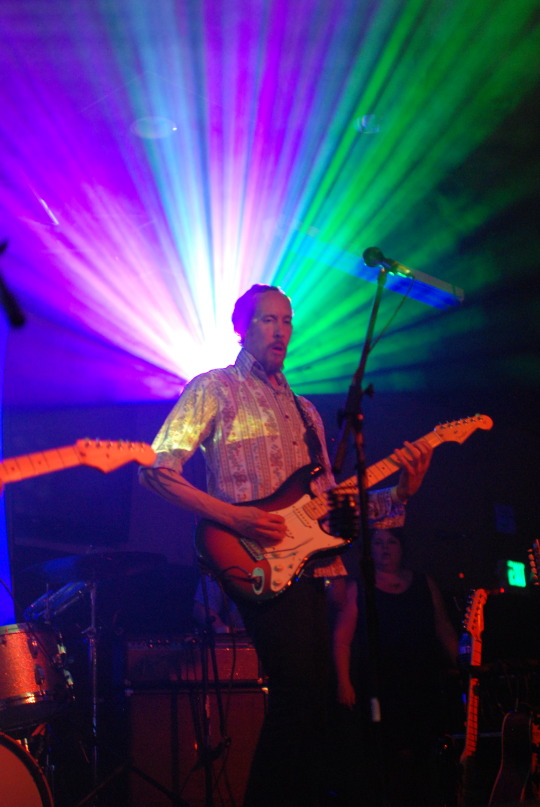
Dave onstage with Pigs on the Wing in 2015
POTW: What is your approach in general terms to getting the David Gilmour sound ? Do you ever improvise or do you tend to play the parts note for note?
DAVE: As for as his sound, I shoot for something in the right ballpark. I’ve never tried to replicate his exact gear or anything, but have rather tried to stick to the spirit of it. For the parts I go mostly note-for-note, leaving windows here and there to be spontaneous. Here again, when I improvise I tend to stick with my perception of the spirit of the music. Once in a while I just cut loose and play off the top of my head, usually during sections where we’ve added jams that aren’t in the original arrangements.
For iconic stuff like the Brick Pt. 2 or Time solos, I play those note-for-note, figuring that fans expect to hear them that way, and also that I can’t improve on perfection. On lesser known stuff I’m more open to interpreting or improvising.
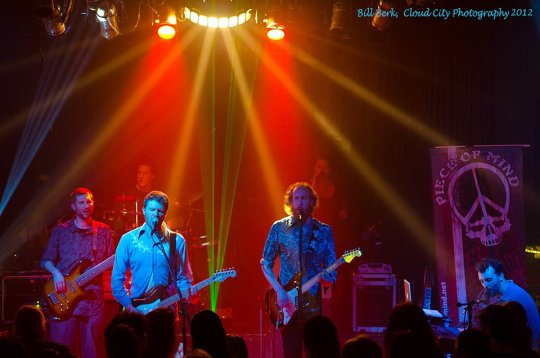
Pigs on the Wing in 2012
POTW: You came into this project after it was established, originally as a 1 guitar band - what was the process like for finding a place for both guitarists ?
DAVE: For me it was mostly a process of playing as little as possible at first and waiting to be invited to add more. I’ve always been a collaborative player, and think of my self as primarily a colorist, so that process happened naturally for me. Over time we had conversations about me taking on some of those iconic note-for-note parts since I knew many of them already. Jason likes to be a little looser and keep things a little more spontaneous, so we evolved organically into roles that suit our strengths as players. We sometimes have guitar practices where we go through each song and fine-tune our parts and how they work together. Generally we try to err on the side of leaving more space and playing less.
I’ve also become the de facto utility player, handling acoustic, lap steel, and other miscellaneous parts. Again this plays to our respective strengths because Jason mostly likes to play electric, whereas I grew up playing 12-string, nylon-string, and things like that. I learned to play songs like Fearless, Is There Anybody Out There?, and Wish You Were Here as part of learning guitar when I was a teenager, so it was natural for me take on that role in the band, to fill that need, if you like.

POTW guitars - onstage - 2018 Finding the Dark Side of the Moon tour
POTW: Let's talk about your guitars. Tell us about your main instrument(s) and why they work for this project.
DAVE: I’m pretty much a maple-neck Strat guy generally, probably because my first decent guitar as a kid was a Japanese Squier Bullet, a 3/4-size Strat body with a maple Tele neck. I played that guitar for 11 years before finally getting a Strat, so by then nothing else felt right in my hands but a Fender with a maple neck! Plus I think they’re more versatile than most other guitars. With the right pickups you can play any style of music with a Strat. I also like that Strats are a bit harder to play than other electrics. They make you work a little harder, so when I dig in things don’t get chaotic, unless I want them to. Over the years I’ve had four different Gibsons - a Les Paul, SG, Firebird, and ES330TD, in that order - and ended up selling all of them eventually.
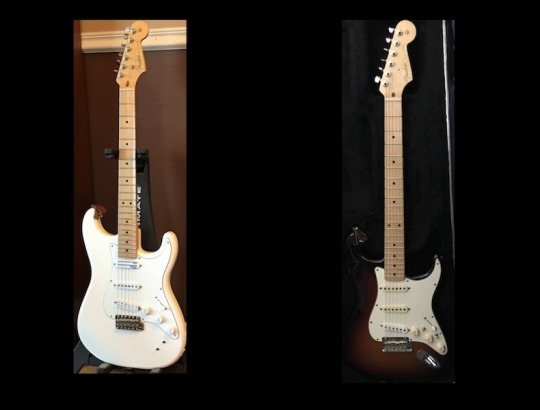
Dave’s Stratocasters
I just got a new Strat that is quickly becoming my main electric - an Ed O’Brien (from Radiohead) signature Strat. It comes stock with pretty much all of the stuff I would want to mod a Strat with, like a Sustainer pickup and a mini-humbucker in the bridge, a Little JB. I had locking tuners put in and had it set up for 10s. I also ended up swapping necks with my now-former main Strat because the stock 21-fret V neck felt weird after 33 years playing C necks, most of which had 22 frets.
I love my Ebow, so the idea of the Sustainer was very appealing to me. I use it on Echoes and plan to use it extensively on Shine On when we bring that back into the set later this year. My now-backup guitar is a heavily modified 2011 sunburst American Standard Strat. I put a Duncan STK6 in the bridge, wired in a coil-tap switch, and put in a switch to add the neck pickup to the bridge out-of-phase. It also has a bone nut and locking tuners. As noted above, it now has the 21-fret V neck from the Ed O’Brien.
I use a Guild 12-string for all steel-string acoustic parts, except for Dogs, for which I play an old Yamaha 6-string tuned to D standard. I play a Yamaha nylon-string acoustic-electric for three songs on The Wall. I also play a Supro 6-string lap steel guitar in drop-D tuning for slide parts.

Dave’s pedalboard setup as of Sept 2018
POTW: How do you generate the distortion and overdrive effects ? Do you use a Big Muff ? How about the Leslie effects? What is the most irreplaceable pedal on your pedalboard ?
DAVE: I mostly use a Fulltone GT500 for distortion. I really prefer amp gain, but somehow ended up going this route a few years ago.
I recently incorporated a backwards-plugged wah to my setup for the creepy whale sounds on Echoes and Is There Anybody Out There? It works great unless you happen to use wireless, so I ended up adding an A/B switch so I can use a cable with the wah and wireless for everything else. I recently got a 5 channel looper pedal with an A/B so the current A/B will go away. It’s like Medusa’s head of snakes - every time I get rid of something, 2 more things take its place!
I have a Boss RT20 rotary speaker pedal that I like a lot. It’s versatile and indestructible. I also have three Analogman-modded pedals that I love - a Small Stone phase shifter, a VPJr volume pedal and a Boss TR2 tremolo. The most indispensable pedal on my board is definitely the Boss DD20 delay. Many Floyd songs are dependent on delay for tempo, so a good-sounding, reliable and programmable delay is crucial, and the Boss is all of those things; and like the RT20, really all Boss stuff, it’s indestructible. Our stuff takes a fair amount of abuse so roadworthiness counts for a lot.
POTW: Gilmour was known for playing through 100 watt Hiwatts at very high volume - what's your amp setup these days, and how is it similar or different from Gilmour's?
DAVE: I’m using a 1967 Fender BandMaster Head with two identical Avatar 2x12 8-ohm cabs. They are of the now-discontinued Vintage Diagonal series, which means the speaker board is mounted on a slight upwards tilt to facilitate being easier to hear on stage. They each have one Vintage 30 and one G12H30 speaker. I have to give a big shout-out to Avatar for making me a second cab to my specs despite discontinuing both the model in particular and custom orders in general.
My setup is different from Gilmour’s in that it is significantly lower wattage - 50 compared to a couple hundred or more, depending on how many heads he uses nowadays - and I play at a comparatively low volume. Similar to Gilmour, my rig is set up for clean headroom as opposed to high gain.
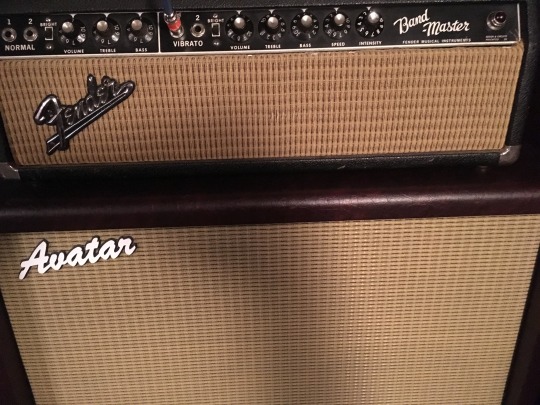
Dave’s amp rig - Sept 2018
POTW: On that note - how is your rig similar or different from Jason's rig ? Is it ever chaos having 2 guitars on stage at the same time ? How do you guys create space for both instruments ?
DAVE: My rig is very different from Jason’s in a couple of ways. He uses an Orange head into a Marshall 4x12, and uses the effects loop for his pedals. His amp has a high gain channel that he uses for most of his leads. My rig doesn’t have an effects loop so my pedalboard runs straight into the amp. Jason uses cables, whereas I am wireless.
On the other hand, we both have pretty similar pedal layouts, including 2 or 3 of the same pedals, and we both use tube amps. I started using Gilmour-style short trem arms after seeing how much Jason liked his, and Jason turned me on to Analogman pedal mods.
It can be a little chaotic with the two of us, especially on really loud and jammy songs like Interstellar Overdrive or the middle part of Echoes. As mentioned earlier, we put a lot of time into arrangements so we don’t step all over each other. It helps that neither of us are showboats or egotists. We’re pretty mellow and considerate. And sometimes a little chaos is a good thing! Mostly we try to avoid having our combined stage volumes blow out the eardrums of our band mates, our audiences, or ourselves, and/or irritate Shira, our FOH sound engineer.

Pigs on the Wing live 2018
POTW: Last question: Boss or EHX pedals ?
DAVE: Yes, please. I am an equal-opportunity pedal nerd.
#pigs on the wing#pink floyd#analogman#fender#stratocaster#david gilmour#guitargeek#pink floyd tribute
3 notes
·
View notes
Text
Let this run in the background if you’re reading...
youtube
I’ve been posting a lot of Joe Pass lately because he was goddamned incredible. An absolute monster of a guitarist. And today, I want to give a little context to the selection above, and talk about what makes an already great performance even more impressive.
Let this run in the background if you read.
***
INTRO
Joe Pass’ hands were preposterously strong for a guitarist, and this selection really gives a great idea of how hard he’s digging in. The interesting context is that the final product of this recording session...one of the absolute iconic gems in the jazz guitar lexicon...was a mistake.
That mistake is what makes the output even more impressive.
Pablo Records were a minor player in the jazz recording world...and Joe Pass, even early in his career, hated recording. A recording studio is quite a few worlds apart from the environment jazz musicians play in, full of contrasts. Jazz doesn’t care about mistakes. Recording sessions will obsess over them.
That dichotomy is what makes this particular session so interesting. Joe Pass was going to do the whole album in a single take. The amplifier he was using, that the engineers had mic’d up? It failed after a single song.
What you hear on this album is Joe Pass’ Gibson ES-175 played acoustically.
***
CONTEXT
I’ve mentioned this in the past, in regards to jazz/archtop guitars. Acoustic and electric worlds require very different instruments and very different strings.
Old acoustic archtops were massive beasts built from solid pieces of wood, strung with roundwound strings, and designed to project through a big band with 12-18 horn players, a pianist, and drummer with no amplification. As the guitar became a solo instrument, largely due to amplification, these styles of guitars became more and more obsolete.
The tradeoff was sacrificing acoustic projection and sound quality for practicality in amplified situations. This is entirely due to changes to the top of the guitar, or the big soundboard where the bridge and pickups are mounted.
The next sections will run through the differences quickly.
***
PICKUP MOUNTING
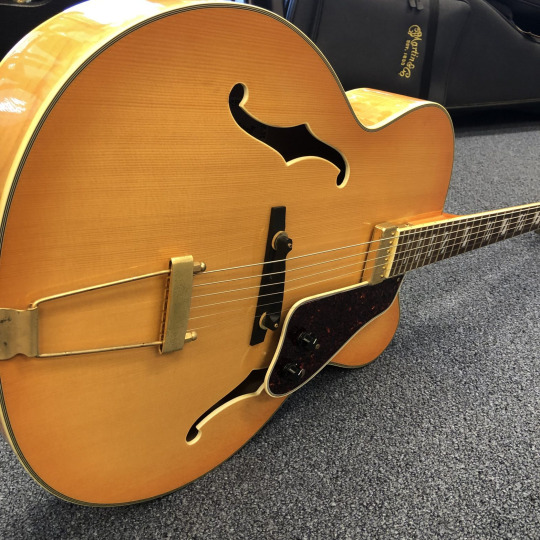
You can see that there’s space between the pickup and the soundboard. This design is so that a guitar can be amplified, but still retain all the qualities of an acoustic guitar as the guitar’s top is allowed to vibrate fully.
As amplification became a bigger factor, and music became louder, these types of pickups suffered due to issues with feedback. The full-measure solution to this problem were semi-hollow and solid bodied guitars...enter Messrs.. Leo Fender (Fender Telecaster and Stratocaster) and Ted McCarty and Les Paul (Gibson ES-335 and Les Paul).
The halfest-measure was one of the iconic guitars of all-time...Joe Pass’ weapon of choice, the Gibson ES-175. Remember that the vibration of the guitar’s top (or soundboard) is what powers an acoustic instrument...and the example of the floating pickup’s unobtrusive nature.
Now you have...not just two pickups mounted on the soundboard...but also the controls and pickup selector. The ES-175 might be a fully hollow guitar...but by no means is it a true acoustic archtop.

***
STRINGS

Rounds on top, flats on bottom.
Simply put, rounds are used on acoustic because they’re brighter, crispier, project better and cheaper. New rounds on an acoustic is where it’s at. Again though, using those big Bismarck-class hollow guitars with floating pickups and zingy rounds...that’s a recipe for feedback issues abound.
Which is why most jazz guys play flats. Flats don’t have the harmonic overtones and brightness of rounds...but they also don’t feedback or have a lot of noise when you drag your fingers along them. Flats are also typically much higher tension, making them more difficult to play with substandard technique. Plus they last for months, if not years.
Joe Pass was playing acoustic guitar with a guitar that had mounted humbuckers and flatwound strings.
***
CONCLUSION
Yet, despite these headwinds, Joe Pass still cut an absolutely stellar album, getting a good sound out of a crappy situation. Here’s the one song that was amplified, and you can hear the sound they were going for before the amp failed.
youtube
In hindsight, it’s a miracle that an engineer had a condenser mic to mix the two signals...as he couldn’t have imagined that a) an amp would fail, and b) Pass would just say “fuck it” and keep going.
But when you listen to these recordings on an instrument that really wasn’t designed to be a featured acoustic instrument, it becomes even more incredible. You can hear just how strong and powerful Pass’ hands were, just digging into that 175 like a fucking backhoe. On “Round Midnight” you can actually hear his pick hitting his guitar/
To put it in perspective, this is like setting a track record at Nürburgring in a Mazda Miata. For the record, here’s Joe Pass on a truly acoustic D’Aquisto. I gotta say, I almost prefer the ES-175 off Virtuoso.
youtube
0 notes
Text
The gear behind Radiohead’s ‘Kid A’ sound in Dublin

Highlight: Jonny’s original ondes Martenot
Radiohead’s tour dates in 2000 were the first time that Jonny publicly performed with an ondes Martenot, and also one of the few tours he performed with the original 80s Martenot played on Kid A and Amnesiac. Although today Jonny is known for popularizing the ondes Martenot in the english-speaking world, until the late-90s he hadn’t so much as seen a picture of one. He only knew it from the sweet melodies and dramatic electronic glissandi in recordings of Olivier Messiaen’s Turangalîla-Symphony. It wasn’t until 1999, when he learned of one for sale in Paris and purchased it with its Palme diffuseur, that Jonny finally became acquainted with the instrument. This acquisition would be pivotal for the recording of Kid A and Amnesiac, and in no short time Jonny was teaching himself the instrument (hence his unusual playing technique) and using it to define the sound of those albums. The songs Kid A, The National Anthem, How to Disappear Completely, Optimistic, Motion Picture Soundtrack, Pyramid Song, You and Whose Army, and Morning Bell / Amnesiac all feature the ondes Martenot – and that doesn’t include the b-sides from this era!
What differentiates the Martenot from other electronic instruments is its interface, the way that the player controls the sound. The Martenot features a very sensitive button (called the “touche”) to control volume, while pitch can be controlled by either a keyboard or a ring on a ribbon. Both the keyboard and the ring can create vibrato by rocking the hand back and forth, and one can hear Jonny play with keyboard vibrato on the album recording of Optimistic. the ring has full control of pitch over the range of the instrument, allowing anything from minute microtones to mutli-octave slides. When using a simple waveform, sliding between notes using the ring creates a sound similar to a theremin – but with greater control – which is why Jonny is often mistaken for playing one on songs like The National Anthem and Pyramid Song.
The ondes Martenot’s sound generators changed over the decades, so different versions are capable of different timbres. While the earliest versions used vacuum tubes, and the version most common today uses transistors, Jonny’s original Martenot is from a briefly made digital version. The digital version uses additive synthesis, and Jonny generally plays with setting that has relatively few overtones, which is why it’s often mistaken for a sine wave. Although monophonic, the Martenot is capable not only of melody but also of many special effects – in fact, most people unwittingly know the Martenot from the soundtracks of films like Ghostbusters and Journey to the Far Side of the Sun.
The 2000 tour was also one of the few times that fans could hear songs performed with the same instrument used on the recordings, since Jonny quickly obtained a replica for touring purposes. Jonny was nervous about the rare Martenot being damaged, so he commissioned a replica that could control the same eurorack synth modules that he uses on Idioteque. The result was the Analogue Systems French Connection, a controller with a less sensitive interface emulating the touche and ring of the Martenot. Jonny would use the French Connection all Radiohead tours from 2001 to 2012, as well as for some recordings and tv performances. And although Jonny did tour with his original Martenot again in 2016 (he had less reason to be nervous of it breaking after getting an ondes Musicales Dierstein in 2011), that too was short lived, because Jonny ceased using the Martenot for touring once he acquired the Asaden Ondomo.
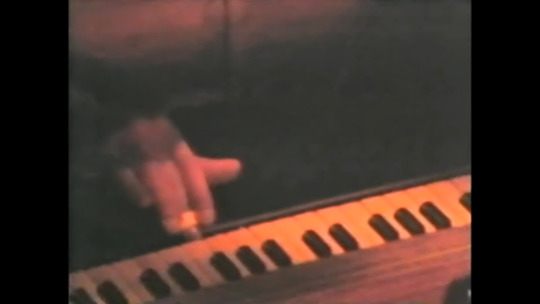
A closeup of Jonny’s ondes Martenot from The National Anthem. The Martenot’s distinctive short-depth (but full width) keys can be seen, as well as the pitch-controlling ring on Jonny’s finger.
Other notable bits:
Radiohead’s 2000 tour saw the first public uses of a ton of instruments that the band had only started using during the sessions for Kid A and Amnesiac. Perhaps most notably, it was the first time that Radiohead used looping and live sampling on tour. This was enabled by a host of performance oriented samplers, like the Korg Kaoss Pad, Line 6 DL4, and Akai Headrush, all of which were released only a year earlier in 1999. Colin bowed a double bass for the first time on Pyramid Song and Motion Picture Soundtrack – a rare treat, as Colin soon after switched to a Steinberger electric upright bass, followed in 2006 by Jonny taking over bowing on Pyramid Song with his guitar (most likely inspired by Jónsi of Sigur Ros, who opened for Radiohead on this very tour). Another rarity was the Vox Super Continental organ which Thom plays on Motion Picture Soundtrack, with the sound distorted through an Electro-Harmonix Micro Synthesizer pedal. Jonny brought his recently acquired Analogue Systems RS8000 on tour to perform Idioteque, marking the first time he’d performed with a eurorack modular synthesizer. It was also the first time Ed performed with a guitar modified to include a sustainer system. The heavily modified Eric Clapton Signature Stratocaster used for the Dublin show would be Ed’s favorite for more than a decade before becoming the inspiration for Ed’s current Fender EOB Signature Stratocaster.
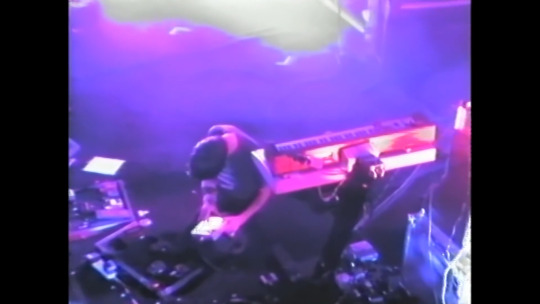
A screenshot of Jonny sampling Thom’s vocals with his Korg Kaoss Pad KP1 during Everything In Its Right Place. One can also see his ondes Martenot atop his Fatar MIDI control, and the Martenot’s Akai Headrush E1 (that light grey rectangle) can be seen below them both.
Song by song:
This lists all gear used for the songs included in the official video of Radiohead’s performance at the Punchestown Race Course in Dublin on October 7, 2000. It does not include other gear used for other songs at the same show, or for the rest of the 2000 tour.
The National Anthem
Thom Yorke‘s gear for The National Anthem in Dublin
Shure Beta 87 vocal microphone
Ring modulator vocal effect from FOH mixing desk
Rickenbacker 330 in Fireglo finish
Tech 21 XXL distortion (most likely, might be another distortion pedal)
Marshall Bluesbreaker amplifier
Jonny Greenwood‘s gear for The National Anthem in Dublin
ondes Martenot (80s digital student model)
Akai Headrush E1 delay/looper (used for Martenot looping)
Roberts R737 radio (processed by Jonny’s guitar pedals)
Electro-Harmonix Small Stone V2 phasor
DOD 440 envelope filter
Demeter The Tremulator tremolo
Digitech Whammy WH1 pitch shifter
BOSS SD1 overdrive
BOSS RV3 reverb/delay
Roland RE201 Space Echo
Vox Egg footswitch (echo cancel for Space Echo)
Ed O’Brien‘s gear for The National Anthem in Dublin
Fender Eric Clapton Signature Stratocaster (ST1) “Sustainer Strat”
Crowther Hotcake and/or BOSS SD1 overdrive
BOSS DD5 delay
BOSS RV3 reverb/delay
BOSS FV300 volume pedal
Vox AC30TBX Dave Petersen Special
Colin Greenwood‘s gear for The National Anthem in Dublin
1972 Fender Precision Bass in Olympic White finish
Lovetone Big Cheese fuzz
Alembic F-1X Tube Preamp
dbx 160A Compressor/Limiter
Gallien-Krueger 800rb amplifier head
Ampeg SVT 8x10 cabinet
Phil Selway - see end of article.

Jonny adjusting the frequency on his radio while adjusting a pedal (likely his Digitech Whammy) with his right foot.

Thom with his Fireglo Rickenbacker 330 during The National Anthem.
How To Disappear Completely
Thom Yorke‘s gear for How To Disappear Completely in Dublin
Shure Beta 87 vocal microphone
Lakewood M14 acoustic guitar
Jonny Greenwood‘s gear for How To Disappear Completely in Dublin
ondes Martenot (80s digital student model)
Akai Headrush E1 delay/looper (used for Martenot looping)
BOSS FV300 (used to mute Jonny’s playing for silent looping)
Ed O’Brien‘s gear for How To Disappear Completely in Dublin
Rickenbacker 360 12-String in Jetglo finish
Crowther Hotcake and/or BOSS SD1 overdrive
Digitech Whammy WH4 pitch shifter ?
Line 6 DL4 delay/looper (as looper) ?
BOSS DD5 delay
BOSS RV3 reverb/delay
BOSS FV300 volume pedal
Vox AC30TBX Dave Petersen Special amplifier
Colin Greenwood‘s gear for How To Disappear Completely in Dublin
1972 Fender Precision Bass in Olympic White finish
Alembic F-1X Tube Preamp
dbx 160A Compressor/Limiter
Gallien-Krueger 800rb amplifier head
Ampeg SVT 8x10 cabinet
Phil Selway‘s gear for How To Disappear Completely in Dublin
Lemon shaker

In this screenshot from How To Disappear Completely, one can see Ed’s Jetglo Rickenbacker 360/12 guitar and his BOSS PN-2 tremolo/pan pedal.
Morning Bell
Thom Yorke‘s gear for Morning Bell in Dublin
Shure Beta 87 vocal microphone
Rhodes Suitcase Piano Mark I 73 electric piano
Jonny Greenwood‘s gear for Morning Bell in Dublin
Fender Telecaster Plus V1 guitar in Tobacco Burst finish
Coin (an actual coin, scrapped against the guitar’s strings to create the sound effects at the end of the song)
Electro-Harmonix Small Stone V2 phaser
BOSS SD1 overdrive
Roland RE201 Space Echo
Vox Egg footswitch (echo cancel for Space Echo)
Vox AC30TB Dave Petersen Special amplifier
Ed O’Brien‘s gear for Morning Bell in Dublin
Shure Beta 87 vocal microphone
Fender Telecaster Standard guitar in white finish
Crowther Hotcake and/or BOSS SD1 overdrive
Line 6 DL4 delay/looper (as looper, using reverse function)
BOSS FV300 volume pedal
Vox AC30TB Dave Petersen Special amplifier
Colin Greenwood‘s gear for Morning Bell in Dublin
1972 Fender Precision Bass in Olympic White finish
Alembic F-1X Tube Preamp
dbx 160A Compressor/Limiter
Gallien-Krueger 800rb amplifier head
Ampeg SVT 8x10 cabinet
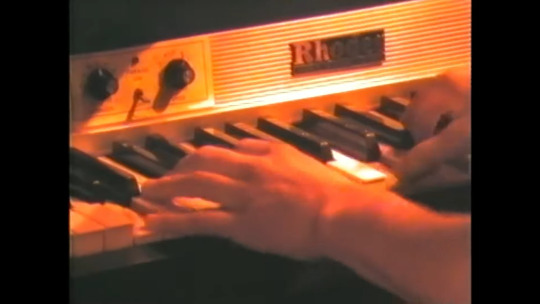
A closeup of Thom’s hands at the Rhodes piano during Morning Bell.
Idioteque
Thom Yorke‘s gear for Idioteque in Dublin
Shure Beta 87 vocal microphone
Jonny Greenwood‘s gear for Idioteque in Dublin
Analogue Systems Sequencer System in RS10 cabinet
Analogue Systems RS8000 Integrator modular synthesizer
Ed O’Brien‘s gear for Idioteque in Dublin
Metal percussion shaker (possibly a guiro shaker)
Fender Telecaste Standard guitar
Crowther Hotcake and/or BOSS SD1 overdrive
Lovetone Ring Stinger ?
Line 6 DL4 delay/looper (as looper)
BOSS DD5
BOSS FV300 volume pedal
Vox AC30TB Dave Petersen Special amplifier
Colin Greenwood‘s gear for Idioteque in Dublin
Yamaha CBX-K1XG keyboard (sends MIDI notes to a sampler)
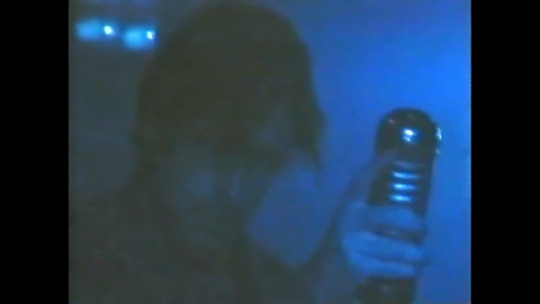
Ed with his metal shaker during Idioteque.

Colin triggering samples with the Yamaha CBX-K1XG during Idioteque.
Optimistic
Thom Yorke‘s gear for Optimistic in Dublin
Shure Beta 87 vocal microphone
Gibson ES-125 electric guitar
Marshall Bluesbreaker amplifier
Jonny Greenwood‘s gear for Optimistic in Dublin
Fender Starcaster guitar (vintage 1970s)
BOSS SD1 overdrive
Roland RE201 Space Echo
Vox Egg footswitch (echo cancel for Space Echo)
Vox AC30TB Dave Petersen Special amplifier
Ed O’Brien‘s gear for Optimistic in Dublin
Shure Beta 87 vocal microphone
Fender Telecaster Standard guitar in white finish
Crowther Hotcake and/or BOSS SD1 overdrive
Vox AC30TBX Dave Petersen Special amplifier
Colin Greenwood‘s gear for Optimistic in Dublin
1972 Fender Precision Bass in Olympic White finish
Alembic F-1X Tube Preamp
dbx 160A Compressor/Limiter
Gallien-Krueger 800rb amplifier hea
Ampeg SVT 8x10 cabinet

In this screenshot from Optimistic, Ed can be seen singing into a Shure Beta 87, while Jonny plays his 70s Fender Starcaster in the background.
In Limbo
Thom Yorke‘s gear for In Limbo in Dublin
Shure Beta 87 vocal microphone
Tambourine
Jonny Greenwood‘s gear for In Limbo in Dublin
Fender Starcaster guitar (vintage 1970s)
BOSS SD1 overdrive
Roland RE201 Space Echo
Vox Egg footswitch (echo cancel for Space Echo)
Vox AC30TB Dave Petersen Special amplifier
Ed O’Brien‘s gear for In Limbo in Dublin
Shure Beta 87 vocal microphone
Rhodes Suitcase Piano Mark I 73 electric piano
Colin Greenwood‘s gear for In Limbo in Dublin
1972 Fender Precision Bass in Olympic White finish
Alembic F-1X Tube Preamp
dbx 160A Compressor/Limiter
Gallien-Krueger 800rb amplifier head
Ampeg SVT 8x10 cabinet

Thom with his tambourine during In Limbo.

Thom at the Rhodes piano and Jonny with his Fender Telecaster and arm brace during In Limbo.
Paranoid Android
Thom Yorke‘s gear for Paranoid Android in Dublin
Shure Beta 87 vocal microphone
Lakewood M14 acoustic guitar
Jonny Greenwood‘s gear for Paranoid Android in Dublin
Shure Beta 87 vocal microphone (“ugly”, “piggy”)
Young Chang upright piano
Fatar CMS-61 MIDI controller (sends MIDI notes to trigger synth string samples)
Fender Telecaster Plus V1 guitar in Tobacco Burst finish
Electro-Harmonix Small Stone V2 phaser
DOD 440 envelope filter
BOSS LS2 line selector
Vox AC30TB Dave Petersen Special amplifier
Marshall Shredmaster distortion
BOSS FV300 volume pedal
Fender Eighty-Five amplifier
Ed O’Brien‘s gear for Paranoid Android in Dublin
Shure Beta 87 vocal microphone
Fender Telecaster Standard guitar in white finish
Crowther Hotcake and/or BOSS SD1 overdrive
Digitech Whammy WH4 pitch shifter
BOSS LS2 Line Selector
BOSS DD5 delay
Vox AC30TBX Dave Petersen Special amplifier
Mesa Boogie Trem-O-Verb amplifier
Colin Greenwood‘s gear for Paranoid Android in Dublin
1972 Fender Precision Bass in Olympic White finish
Alembic F-1X Tube Preamp
dbx 160A Compressor/Limiter
Gallien-Krueger 800rb amplifier head
Ampeg SVT 8x10 cabinet
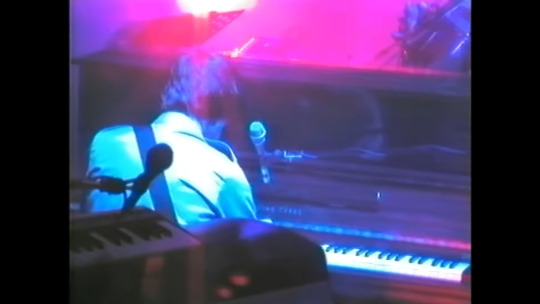
Jonny at the Young Chang upright piano during Paranoid Android – a rare instance of Jonny not using the Rhodes piano for this section.
Motion Picture Soundtrack
Thom Yorke‘s gear for Motion Picture Soundtrack in Dublin
Shure Beta 87 vocal microphone
Vox Super Continental organ
Electro-Harmonix Micro Synthesizer (vintage "big box" version used to distort the organ’s sound)
BSS Audio AR-133 Active D.I. Box (used to connect the pedal to the PA mixer)
Jonny Greenwood‘s gear for Motion Picture Soundtrack in Dublin
Fatar CMS-61 MIDI controller (sends MIDI notes to trigger harp and choir samples)
Colin Greenwood‘s gear for Motion Picture Soundtrack in Dublin
Double bass
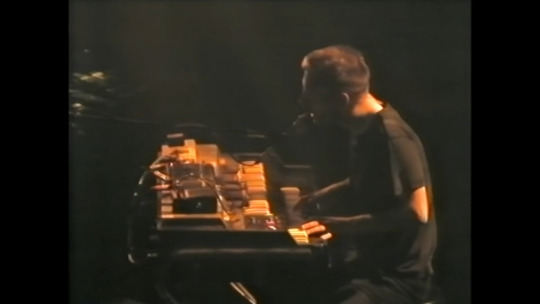
Thom playing the Vox Super Continental organ. The EHX Micro Synth and BSS Audio DI box can be seen on top of the organ, along with a power strip with power supplies.

Colin with his double bass and bow, presumably checking to ensure he has enough rosin and tension on the bow.
Everything In Its Right Place
Thom Yorke’s gear for Everything In Its Right Place in Dublin
Shure Beta 87 vocal microphone
Rhodes Suitcase Piano Mark I 73 electric piano
Jonny Greenwood’s gear for Everything In Its Right Place in Dublin
Korg Kaoss Pad KP1 sampler (fed from Thom’s vocals)
Electro-Harmonix Small Stone V2 phasor
DOD 440 envelope filter
Demeter The Tremulator tremolo
Digitech Whammy WH1 pitch shifter
BOSS SD1 overdrive
BOSS RV3 reverb/delay
Roland RE201 Space Echo
Vox Egg footswitch (echo cancel for Space Echo)
Ed O’Brien’s gear for Everything In Its Right Place
Pedals are fed from Thom’s Rhodes Piano.
Line 6 DL4 delay/looper (as looper)
Akai Headrush E1 delay/looper (as looper)
BOSS DD5 delay
BOSS FV300 volume pedal
misc others
Colin Greenwood‘s gear for Everything In Its Right Place in Dublin
1972 Fender Precision Bass in Olympic White finish
Alembic F-1X Tube Preamp
dbx 160A Compressor/Limiter
Gallien-Krueger 800rb amplifier head
Ampeg SVT 8x10 cabinet

A screenshot of Thom at the Rhodes piano during . One can also see the distinctive red control panel of Jonny’s Vox AC30TB Dave Petersen Special.
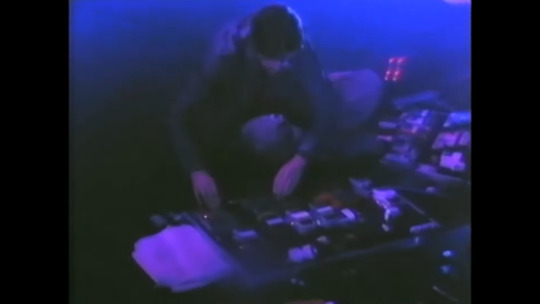
Ed adjusting his Line 6 DL4 and Akai Headrush E1 – both configured as loopers – during Everything In Its Right Place.

In this screenshot from Everything In Its Right Place, one can see Jonny’s 80s ondes Martenot and Fatar CMS-61 (left), as well as his BOSS SD1 and BOSS RV3 pedals (right).
Just
Thom Yorke‘s gear for Just in Dublin
Shure Beta 87 vocal microphone
Fender Telecaster Deluxe guitar (vintage 1970s)
Thom uses the guitar’s pickup selector as cutoff switch during outro section.
Proco Turbo Rat distortion (most likely, might be another dirt pedal)
Marshall Bluesbreaker amplifier
Jonny Greenwood‘s gear for Just in Dublin
Fender Telecaster Plus V1 guitar in Tobacco Burst finish
Electro-Harmonix Small Stone V2 phaser
DOD 440 envelope filter
Digitech Whammy WH1 pitch shifter
BOSS LS2 line selector
Vox AC30TB Dave Petersen Special amplifier
Marshall Shredmaster distortion
BOSS FV300 volume pedal
Fender Eighty-Five amplifier
Ed O’Brien‘s gear for Just in Dublin
Fender Stratocaster (70’s) in white finish with black pickguard
Crowther Hotcake and/or BOSS SD1
BOSS FV300 volume pedal
Mesa Boogie Trem-O-Verb amplifier
Colin Greenwood‘s gear for Just in Dublin
1972 Fender Precision Bass in Olympic White finish
Alembic F-1X Tube Preamp
dbx 160A Compressor/Limiter
Gallien-Krueger 800rb amplifier head

Ed can be seen with his white 70s Strat in this screenshot from Just.
Phil Selway’s Drum Setup
Phil’s drum kit is not especially visible in footage from the show. However, he described his setup at the time in the July, 2001 issue of Rhythm magazine:
“I don’t have my whole kit set up here today. I generally have 12”, 14” and 16” toms and a Noble & Cooley snare that I put on my left-hand side. I’d normally have drum triggers and a pad on the kit too, to the right of my 12” tom. The kick drum and both snares have triggers on – just for individual samples, because we don’t tend to use loops live.
“My acoustic drums are all premier Signia Marquis. They look after me really well and have done for six years – they sent me a Club kit recently, which I love. Cymbals are a mix of Zildjian Ks and As usually. I like quite dry cymbals – things that sound quite contained. It’s quite a simple set-up, really, and I don’t want for anything. Apart from snares. You can never have too many snares.”
The Zildjian K Cymbals are as follows:
13” Hi-Hats
12” Splash
15” Thin Crash
16” Crash
18” Ride
The triggers are by ddrum, and are used to control Phil’s Clavia Nord Drum 1.

Phil’s Nord Drum can be seen in this screenshot from Idioteque.
#Radiohead#Dublin#2000 tour#Thom Yorke#Jonny Greenwood#Ed O'Brien#Colin Greenwood#Phil Selway#Kid A#Amnesiac#The National Anthem#How To Disappear Completely#Morning Bell#Idioteque#Optimistic#In Limbo#Paranoid Android#Motion Picture Soundtrack#Everything In Its Right Place#Just#ondes Martenot#ondes Musicales#Ondomo#Pyramid Song#YoutubeStreams2020
17 notes
·
View notes








